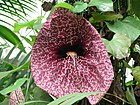Note: This is a project under development. The articles on this wiki are just being initiated and broadly incomplete. You can Help creating new pages.
Aristolochia grandiflora - Duck flower
Aristolochia grandiflora is the pelican flower and it is a deciduous vine with one of the world's largest flowers that emits an odor that smells like rotting meat, attracting flies.
Contents
[hide]- 1 Uses
- 2 Parts Used
- 3 Chemical Composition
- 4 Common names
- 5 Properties
- 6 Habit
- 7 Identification
- 8 List of Ayurvedic medicine in which the herb is used
- 9 Where to get the saplings
- 10 Mode of Propagation
- 11 How to plant/cultivate
- 12 Commonly seen growing in areas
- 13 Photo Gallery
- 14 References
- 15 External Links
Uses
Increase sexual desire, Snakebite, Intestinal pain, Gallbladder pain, Arthritis, Gout, Achy joints, Rheumatism, Eczema, Weight loss, Wounds.[1]
Parts Used
Chemical Composition
It includs aristolochic acids and esters, aristolactams, aporphines, protoberberines, isoquinolines, benzylisoquinolines, amides, flavonoids, lignans, biphenyl ethers, coumarins, tetralones, terpenoids, benzenoids, steroids, and others[2]
Common names
| Language | Common name |
|---|---|
| Kannada | Isvaberusa |
| Hindi | Hookbel |
| Malayalam | NA |
| Tamil | Isvaramuli |
| Telugu | Esvaraveru |
| Marathi | NA |
| Gujarathi | NA |
| Punjabi | NA |
| Kashmiri | NA |
| Sanskrit | Gandhanakuli |
| English | NA |
Properties
Reference: Dravya - Substance, Rasa - Taste, Guna - Qualities, Veerya - Potency, Vipaka - Post-digesion effect, Karma - Pharmacological activity, Prabhava - Therepeutics.
Dravya
Rasa
Guna
Veerya
Vipaka
Karma
Prabhava
Habit
Identification
Leaf
| Kind | Shape | Feature |
|---|---|---|
Flower
| Type | Size | Color and composition | Stamen | More information |
|---|---|---|---|---|
| {{{5}}} |
Fruit
| Type | Size | Mass | Appearance | Seeds | More information |
|---|---|---|---|---|---|
Other features
List of Ayurvedic medicine in which the herb is used
Herboline, Kalnaaru Parpam, Meganatha Tailam[1]
Where to get the saplings
Mode of Propagation
How to plant/cultivate
A plant of the lowland tropics, where it is found at elevations up to 600 metres. Prefers a well-drained, humus-rich, loamy soil and a position in full sun or partial shade[4]
Commonly seen growing in areas
Along streams, Secondary-growth thickets, Steam banks.
Photo Gallery
References
- ↑ Jump up to: 1.0 1.1 1.2 1.3 "Karnataka Medicinal Plants Volume - 3" by Dr.M. R. Gurudeva, Page No.216, Published by Divyachandra Prakashana, #45, Paapannana Tota, 1st Main road, Basaveshwara Nagara, Bengaluru.
- Jump up ↑ Chemistry
- Jump up ↑ [Morphology]
- Jump up ↑ Cultivation
External Links
- Ayurvedic Herbs known to be helpful to treat Increase sexual desire
- Ayurvedic Herbs known to be helpful to treat Snakebite
- Ayurvedic Herbs known to be helpful to treat Intestinal pain
- Ayurvedic Herbs known to be helpful to treat Gallbladder pain
- Ayurvedic Herbs known to be helpful to treat Arthritis
- Ayurvedic Herbs known to be helpful to treat Gout
- Ayurvedic Herbs known to be helpful to treat Achy joints
- Ayurvedic Herbs known to be helpful to treat Rheumatism
- Ayurvedic Herbs known to be helpful to treat Eczema
- Ayurvedic Herbs known to be helpful to treat Weight loss
- Ayurvedic Herbs known to be helpful to treat Wounds
- Herbs with Stem used in medicine
- Herbs with Leaves used in medicine
- Herbs with Roots used in medicine
- Herbs with common name in Kannada
- Herbs with common name in Hindi
- Herbs with common name in Tamil
- Herbs with common name in Telugu
- Herbs with common name in Sanskrit
- Habit - Climber
- Index of Plants which can be propagated by Seeds
- Index of Plants which can be propagated by Softwood cuttings
- Herbs that are commonly seen in the region of Along streams
- Herbs that are commonly seen in the region of Secondary-growth thickets
- Herbs that are commonly seen in the region of Steam banks
- Herbs
- Aristolochiaceae







